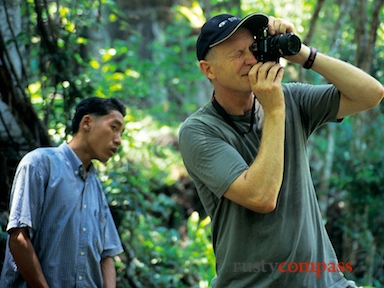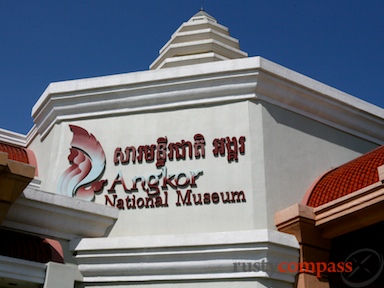The more frequently I confront the policy, the more I want to understand it. Why should museums prevent travellers from taking photographs? As more and more travellers view photography as an increasingly important part of their travel experience investing ever more in advanced digital cameras, why stand in the way? A photograph is a sign of appreciation and interest in the space or objects contained within it. Shouldn't a museum be flattered by the interest?
So why prevent it?

Photo: Mark BowyerPhotographing the treasures at Angkor is fine
And what of ancient and World Heritage sites where visitors might reasonably question whether museums as custodians of these inheritances of all humanity, have a right to stand in the way of visitors wanting to further enrich their experience with photography.
I've asked curators and security guards to explain the prohibition.
At the newly minted Thai owned Angkor National Museum in Siem Reap, I was advised by management that photography was not allowed because of concerns that photos may be used to create copies of the pieces held in the museum. This seemed a peculiar concern given that extensive imagery from this and other museums holding Angkor era artefacts are available in books. Further, one of the most inspired tourism driven cottage industries in Cambodia is the creation of beautiful reproduction carvings of stone and wood from Angkorian statues by local people. Paris's Guimet Musee which holds the most extensive collection of Khmer art outside Cambodia permits photography.
Perhaps a member of staff at the National Museum in Phnom Penh was closer to the truth when she said that photography was restricted to encourage sales of the Museum's souvenir book.

Photo: Mark BowyerBut keep your camera off in this new and largely empty museum
So what is the reason?
I can only come up with four explanations - a risk that photography (flash photography) might damage the object/s in question, the possibility that photographers might significantly compromise the experience of other viewers of the sight or object, objections based on intellectual property ownership and objections based on religious or spiritual grounds.
The flash photography damage issue is reasonable, if it is legitimate. In my recent travels though, it would not have applied . It would take quite a lot of flash photography to damage stone items.
Museums might legitimately wish to restrict flash photography in the interests of other visitors. I agree that flash photography can be intrusive. As cameras even at the consumer end have become increasingly sophistocated, flash free photography has become possible for a high percentage of digital photographers. A flash ban might well be reasonable.
None of the museums I visited recently were sufficiently busy that photographers would compromise the flow of visitors. In fact the museums of Cambodia and Vietnam with the exception of the War Remnants Museum in Saigon and the National Museum in Phnom Penh, were remarkably empty. And many of the world's busiest museums do allow photography - the British Museum for example.
Issues of intellectual property or religious custom are a given and I have not encountered restrictions based on these grounds during recent travels.
Photography might also provide a much needed boost to museums suffering flagging numbers. Personal photography on blogs, flickr and facebook entries provide a great opportunity for museums to cost effectively make their collections known to the world. Is this is not one of the primary functions of a museum?
A closer eye on the rationale behind restricting photography would definitely make for a more satisfying experience for travellers.
As photography becomes ever more important to more and more travellers, museums should think hard about why they are restricting a natural traveller impulse.
And what of extra charges for photographers? I'm not a fan of course but on the basis that photographers are making a greater imposition on museum space and that they are obtaining greater utility from their visit, I'd much rather see a small additional fee than blanket bans.




There are no comments yet.